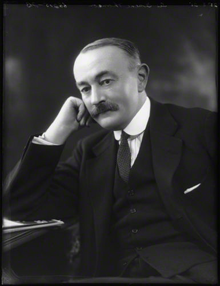Graeme Thomson
Sir Graeme Thomson | |
|---|---|
 | |
| 26thGovernor of British Ceylon | |
| In office 11 April 1931 – 20 September 1933 | |
| Monarch | George V |
| Preceded by | Bernard Henry Bourdillon (Acting governor) |
| Succeeded by | Francis Graeme Tyrrell (Acting governor) |
| Governor of Nigeria | |
| In office 13 November 1925 – 17 June 1931 | |
| Preceded by | Hugh Clifford |
| Succeeded by | Donald Charles Cameron |
| Governor of British Guiana | |
| In office 4 April 1923 – 31 August 1925 | |
| Monarch | George V |
| Preceded by | Wilfred Collet |
| Succeeded by | Cecil Hunter-Rodwell |
| Personal details | |
| Born | 9 August 1875 |
| Died | 28 September 1933 (aged 58) Aden |
| Citizenship | British |
Sir Graeme ThomsonGCMGKCB(9 August 1875 – 28 September 1933) was a British civil servant in theAdmiralty,who served as a colonial civil servant and then governor in several British colonies.
Admiralty clerk
[edit]Graeme Thomson was educated atWinchesterandNew College, Oxfordand joined the civil service in 1900, being assigned to theAdmiralty.[1]
Director of Transports
[edit]Shortly after the outbreak of war, he received extremely rapid promotion, from a superintending clerk to Civil Assistant Director of Transport in September 1914 and toDirector of Transportsat the Admiralty in December,[2][3]succeedingAdmiral Savory.
Winston Churchillpraised him after stating over a million troops had been moved:
The credit for these arrangements lies very largely with the head of the Admiralty Transport Department, Mr. Graeme Thomson—one of the discoveries of the War, a man who has stepped into the place when the emergency came, who has formed, organised, and presided over performances and transactions the like of which were never contemplated by any State in history. Indeed, so smoothly and unfailingly has this vast business, the like of which has not been previously witnessed, been carried through, that we have several times been compelled to remind the soldiers whom we serve, and I now think it right to remind the House, that, after all, we are at war.[4]
The AdelaideAdvertiserdescribed him in 1915 as:
A tall, soldierly-looking man with the face of a diplomat, the forehead of a thinker, a square chin, and a bushy moustache, Mr. Thomson's appearance conveys the impression of a rare combination of organising ability, accuracy, judgment, resource, and rapid assimilation of ideas.[2]
In 1917, the Directorate of Shipping for the Ministry of Shipping and Admiralty was created and Thomson was placed in charge of it.[1]
Colonial Service
[edit]After the war government involvement in shipping declined and his post was abolished. He then joined theColonial Service,being appointed asColonial Secretary of Ceylonin 1919, thenGovernor of British Guianain 1922[5]and ofGovernor of Nigeriain 1925, and finally ofGovernor of Ceylonin 1931.[6]He died atAdenon his way home from there.[1]
He had been appointed Knight Grand Cross of theOrder of St Michael and St Georgein the1928 New Year Honours.[7]
References
[edit]- ^abcObituary inStraits Times
- ^abThe Advertiser(Adelaide, South Australia), 1 April 1915, page 7, column 7.
- ^Edward Walford.The county families of the United Kingdom; or, Royal manual of the titled and untitled aristocracy of England, Wales, Scotland, and Ireland(Volume ed.59, yr.1919), 353.
- ^Hansard, 15 February 1915, Naval estimates statement.
- ^"No. 32751".The London Gazette.29 September 1922. p. 6896.
- ^"No. 33689".The London Gazette.13 February 1931. p. 1003.
- ^London Gazette supplement
- Governors of British Ceylon
- 1875 births
- 1933 deaths
- British civil servants
- Governors of British Guiana
- British governors and governors-general of Nigeria
- Chief Secretaries of Ceylon
- Members of the Legislative Council of Ceylon
- British expatriates in Sri Lanka
- 19th-century British people
- Alumni of New College, Oxford
- People educated at Winchester College
- Knights Grand Cross of the Order of St Michael and St George
- Knights Commander of the Order of the Bath
